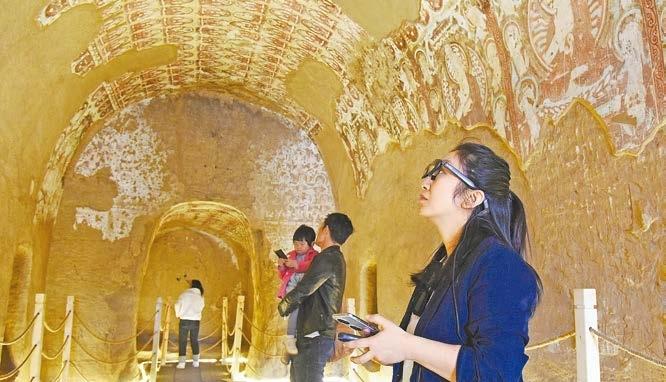
TWO Buddhist cave complexes along the ancient Silk Road in Northwest China’s Xinjiang Uygur Autonomous Region has recently opened to the public for the first time. The Ya’er Lake Grottoes, part of a UNESCO World Heritage site in the city of Turpan, welcomed visitors following a year of restoration work and digital upgrades. “Wearing VR glasses, we learned the grottoes’ history and saw digitally restored Buddha statues. The visuals were incredibly lifelike, creating a truly immersive experience,” said Wang Juan, a tourist from Korla. Formerly serving as a monastery, the grottoes are composed of 22 caves dating back to the fifth century and containing Buddhist murals and inscriptions in multiple languages, including Chinese and Old Uygur. The caves are arranged in two tiers: an upper level which served as meditation spaces for monks, and a lower level which likely functioned as a living area. Cave 4 and Cave 7 are currently open to the public. The grottoes are part of the Jiaohe Ruins — among the largest and best-preserved ancient clay cities in the world and one of the sites along the ancient Silk Road added to the UNESCO World Heritage list in 2014. Wang Jiandong, head of the ruins’ administrative office, said that the restoration team adopted a digital approach to their work, allowing visitors to experience the artistic appeal of the millennia-old grottoes through an immersive blend of virtual and physical elements. In 2014, a joint application from China, Kazakhstan and Kyrgyzstan led to the inclusion of the ancient Silk Road on the UNESCO World Heritage list. China is home to 22 of the Silk Road’s 33 UNESCO heritage sites. There are another eight in Kazakhstan, and three in Kyrgyzstan. The route, which started in Xi’an in Shaanxi Province, was once the main corridor for trade and cultural exchange between Asia and Europe. Some 40 km away, four caves of the Shengjinkou Grottoes in Turpan also opened to the public on the same day, set to offer 300 visitor slots per day. The Shengjinkou site has 13 caves dating back to the seventh century, where murals, woodware, pottery, fabrics and paintings on silk have been unearthed. Since 2012, China has invested 29.79 million yuan (US$4.14 million) in five related conservation projects, including reinforcement and mural restoration, laying the groundwork for the public opening of the Shengjinkou Grottoes. The Turpan Basin is home to 14 grotto sites collectively encompassing over 400 caves, including the Shengjinkou and Ya’er Lake sites. As Turpan was a critical node on the ancient Silk Road, its grottoes reveal a unique fusion of Buddhist traditions, reflecting its role as a Buddhist hub linking Central Asia and China.(Xinhua) | 
